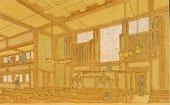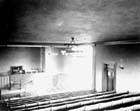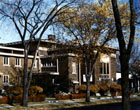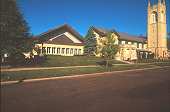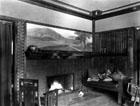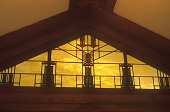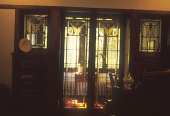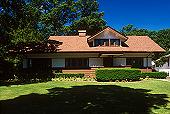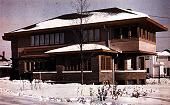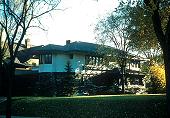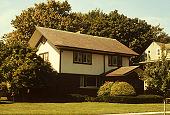|
|
|
Purcell and Elmslie, Architects Firm active :: 1907-1921
Minneapolis, Minnesota :: Chicago,
Illinois |
Ye Older Grindstones
11/8/2002
Oops Dept. I have to restate the size of this site's statistics because I didn't notice the FrontPage report was counting pages not directly related to P&E. Learn something new everyday.
11/7/2002
Incidental housekeeping, including a brief account of the history of this site in permutation since 1995.
11/6/2002
Transcribed a long letter from George Elmslie to Frank Lloyd Wright, date October 30, 1932.
11/5/2002
Started the process of getting up the Catherine Gray residence by adding 45 images. The built house is the result of a failed first attempt, as Purcell explains humbly in his Parabiographies entry. Purcell occupied the house for about a year before his grandmother, the widow of William Cunningham Gray, came to live with him. After Purcell married he and his first wife Edna moved to an apartment that would eventually be across the hall from George Elmslie and his new wife Bonnie. Clearly, Catherine Gray and Edna did not get along. When Purcell built a house for his wife across the alley from the lakeside location of the home where Catherine Gray now lived, he called it the Edna S. Purcell residence. Thus was the domestic world, for a time anyway, brought in to some semblance of balance between the two women in his life. More on this later, especially with a wonderful discovery I noticed for the first time tonight about the failed attempt, which perhaps ten years later was not so failed, after all--just incompletely conceived by a young architect.
11/4/2002
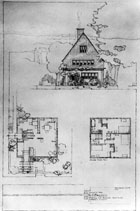
Added the first images of the exquisitely economical jewel of all P&E small houses, the C. T. Backus residence in Minneapolis, Minnesota (1915).
11/1/2002
Rendering, interior
Stewart Memorial Church
Interior, circa 1910s
Exterior, circa 1950sSpent part of this day at the Getty Center, looking through the microfiche of the Frank Lloyd Wright correspondence. I find it remarkable that for such a large body of correspondence so little of it descends from Purcell and Elmslie--especially since FLLW offered his practice to them when he was departing for Europe in 1909 and FLLW had known Elmslie since the late 1880s. I wrote about that fiasco of the partnership offer in the Minnesota 1900 essay. The most interesting surviving letters date from the 1930s, such as when on October 30, 1932, George Elmslie wrote to FLLW to set the record straight, at least in his mind, of what really happened in the Sullivan office after a read of Wright's Autobiography; and June 12, 1936 GGE let FLLW have it with both barrels over comments by Wright about Hugh Morrison's Sullivan biography. David Gebhard and other scholars in the 1960s suppressed the 1936 letter from Elmslie by refusing to publish it (the correspondence stating this flatly can be found in the Purcell Papers), thinking it reflected poorly on Elmslie. These exchanges, together with some quite condescending remarks directed toward Purcell, constitute a thin sad collection of about eight letters, all told.
Of course, you are going to want to read these letters for yourself, but transcription may take a day or two hence:
- GGE to FLLW, October 30, 1932
- GGE to FLLW, June 12, 1936
- FLLW to GGE, June 20, 1936 (pending approval to publish from FLLW Archives)
In addition to acquiring new research materials, I also added 22 images for the Stewart Memorial Church, now beautifully restored, in Minneapolis. This is one of those jobs where I have photographs and slides galore, and need to get them scanned.
10/28/2002
Chancel and Parish House
Christ Church
Community Hall
First Congregational ChurchAdded images for two churches in Eau Claire, Wisconsin. The Christ Church bears some comment but which I will leave entirely to William Gray Purcell to make. Read his Parabiographies entry about this obviously historicist rendering, the sole overt lapse of intention in the entire canon. Of course, it was early in 1908 and the office was trying to network. Much valuable work did later come out of these contacts, particularly the Parsonage and Community Hall for the First Congregational Church. In one of the stranger seeing-isn't-believing instances of Progressive architecture, the bell-towered stone sanctuary on the right of the First Congregational Church image above was built ten years AFTER the P&E Community Hall on the left. The original 19th century wooden church burned, and the Prairie architects had folded their tents and slipped into history by the time the debris from the fire was cleared away. The veterans of WWI had come back from the cities of Europe with eyes wide shut, and they were the ones footing the bills. No doubt, they thought the all-stone Gothic reprise was an improvement over the potential for more charred wood, the great irony being that the fortunes of Eau Claire rested on timber.
Fireplace nook, with mural by Albert Fleury
Charles A. Purcell residence, circa 1910
"The Smoker" panel, 1909
Elmslie doors to "The Smoker," 1915
Henry Einfeldt residenceAlso added 53 images for two neatly related houses in River Forest. Charles A. Purcell commissioned a small house from his son in 1909, which was later embellished with some Elmslie-designed enrichments, mostly sawed wood and leaded glass, along with some electroliers, in 1915. The differences between William Gray Purcell's early conception of decoration for domestic space can be seen in his stencil treatment around the fireplace nook prior to the Elmslie re-do. The original leaded glass panel in a room set aside for his father to enjoy a cigar, "The Smoker," is obviously an homage to Frank Lloyd Wright's imagery. It is very interesting to look at the furniture, too, in the 1909-1914 era; there is strong relationship to chair designs he made for his original house on Lake of the Isles, later known as the Catherine Gray house. While the originals have long since vanished, reproductions can be seen in the dining room at Lake Place, courtesy the Minneapolis Institute of Art. The second house in River Forest, located just a short distance away, was for Henry Einfeldt, a longtime business partner of Charles Purcell. This is a poem to the linearity of the suburban lot and the simple tastes of the very conservative man for whom the house was designed. Sadly, Purcell's father never liked the house he got, and in the 1920s built another one not too far away. He allowed his son to design it with strict stipulations about both plan and appearance. He received a faux Tudor the second time around. No word on whether Einfeldt ever cared for his own house, or not.
10/27/2002
Added Site Statistics. Over 3,200 pages, 2,200 images, and 10,000 links now in service. And to think that I have at least that much more to go.
Finally sorted through all the reports FrontPage makes, and corrected the broken or malformed links that accumulate not only from my own mistakes but also from the pokiness of the computer I use to do this work. FrontPage is a leading bloatware, and even adding another 128MB RAM to this old Pentium 2 did not help. Actually, I think it hindered. It now takes about 45-50 seconds to add a single link, or correct an existing one. I have taken to editing the HTML directly with Find and Replace wherever possible to avoid having to wait a seeming eternity to code for new web browsers, external links, and the like. Still, not much global changes are going to do for a single link. I saw a cherry Pentium 4 for $679 this week. It might as well have been on Mars.
10/23/2002
Completed the enlarged views for the Minnesota Phonograph Company.
10/21/2002
Powers house, as seen in 1914
Powers house, ca.1950
Charles Purcell house, as seen in 1914
Charles Purcell house, circa 1982Eight days gone by. Sigh. Added 68 images, including some more
Credit: Photograph by Scot Zimmerman
of the Edward L. Powers house in Minneapolis (1910). Interesting, if sadly so, to watch this house age. The beautiful color scheme fades away over the decades, like almost all P&E houses save the meticulously restored Lake Place. Same thing happened to the house Purcell built for his father, Charles A. Purcell (1909). In the 1950s, Purcell actually painted a photograph to show what the original intention for the color scheme had been. Although the Lumiere view for the Purcell house has weakened with time, you can still see how ephemeral the exterior finish turned out to be. The view above was taken just before some Elmslie-designed sawed wood was placed beneath the porch roof.Also added the Fritz Carlson house, some Minnesota State Art Commission competition drawings, and the Arthur Jones barn-to-house conversion project that launched the small open-plan house continuum.

